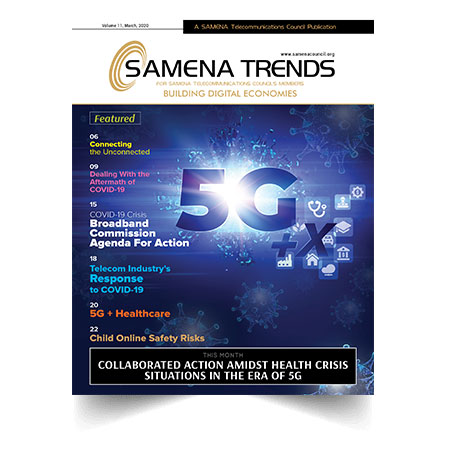
ISLAMABAD – Business leaders and Information Technology experts from Pakistan and across the region have called for unleashing the potential of 5G networks to boost economies and societies in a post COVID-19 environment.
The experts gathered at SAMENA Telecommunication Council Leaders’ Summit, a dedicated Huawei 5G Ecosystem Conference held for the third consecutive year under the theme “Unleash 5G potential, build a better world”.
Telecommunications leaders and experts from Pakistan and across the world gathered at the Summit to review plans for unleashing the potential of 5G networks to boost economies and societies in a post COVID-19 environment. Held virtually for the first time due to social-distancing requirements, the Summit was hosted by Huawei for the seventh consecutive year.
Chairman of the Pakistan Telecommunication Authority Maj. Gen. Amir Azeem Bajwa has said that 5G ecosystem would serve as the bedrock of sustainable socio-economic development in Pakistan.
Bajwa said the deployment of this transformative technology should be precisely timed, supported by intelligent regulatory initiatives, enabled by adequate spectrum resources, under favorable market conditions, and with consensus of all stakeholders.
“I believe that readiness of our telecom infrastructure will be sufficient to support 5G networks and services across the country,” Chairman PTA asserted.
Tania Aidrus, Special Assistant to the PM for Digital Pakistan, said Pakistan has to really think of the Internet as one of the most democratizing forces.
“How do we ensure that we are helping young people come out, apply their skills, apply their knowledge, and apply their creativity to innovate for the country? And really, a government’s job here is to clear the path,” she observed.
Charles Yang, President of Huawei Middle East, in his keynote address said that although the pandemic has brought uncertainty to our lives, the advantages of 5G infrastructure are increasingly clear.
“The outbreak has led to increased demand for ICT solutions specifically in areas like 5G amid a boost in network usage and 5G 2B innovations. Meeting that demand will require new forms of public-private partnerships based on open collaboration, supporting strong industry policies that will enable social value, economic development, and provide enhanced service experiences to consumers across the region,” he maintained.
Anjian, President of Carrier Networks Business Group at Huawei Middle East added that the ICT industry is the foundation and cornerstone of socio-economic restoration today.
“Quite simply, 5G brings agility, productivity, security, and intelligence to all industries. Moving forward, stakeholders should work on five different aspects to realize 5G momentum for consumers, enterprises, and governments. This includes a focus on technology innovation, ecosystem amplification, standards unification, business exploration, and growth-oriented collaborative policy. In the post-pandemic era, multi-level collaboration will be the only way to navigate through tough times.”
Queen Silvia of Sweden, Founder of World Childhood Foundation; Houlin Zhao, Secretary General of the ITU; Mats Granryd, Director General GSMA; Isabelle Mauro, Head of Telecommunications at the World Economic Forum in the USA; Mark Spelman, Head of Thought Leadership at the World Economic Forum in Switzerland; and Dr. Boutheina Guermazi, Director – Digital Development at The World Bank Group in the USA also attended.
Summit attendees also included senior executives from telecommunications service providers, local regulatory authorities, global NGOs, and other ICT industry professionals representing decision makers for different verticals and government entities in countries from across South Asia, the Middle East, North Africa, Asia, Europe, and beyond.
The Summit was held under the theme “5G-X: Harnessing 5G Across Industries for Investment Revival” and highlighted how technology and ICT infrastructure play a significant role in our societies and economies.
The COVID-19 pandemic demonstrated the need to strengthen digital infrastructure to better prepare societies for future crises and to make systems more resilient and sustainable, guaranteeing a better and more effective outcome.
A shift to cloud, IoT, and better integration of AI into the public health response was also spotlighted, in addition to harnessing of other technologies for smart service delivery, which should be a key priority moving forward.
SAMENA Telecommunications Council Leaders’ Summit stressed on topics which are more societal in nature than business-focused, but are essential to industry dialogue. Attending speakers shed light on the impacts of collaborative efforts when deploying technology in the Middle East region to overcome digital transformation challenges. The Summit also explored how ICT stakeholders can work together with industry verticals to turn their vision into reality at the local and regional level.
Summit highlights included a dedicated Huawei 5G Ecosystem Conference held for the third consecutive year under the theme “Unleash 5G potential, build a better world”. Participants reviewed 5G ecosystem cooperation in the Middle East, and how 5G paired with complementary technologies such as cloud, AI, and AI-driven autonomous and BVLOS commercial drone applications, can inspire new vertical industry applications.
Summit attendees also included senior executives from telecommunications service providers, local regulatory authorities, global NGOs, and other ICT industry professionals representing decision makers for different verticals and government entities in countries from across South Asia, the Middle East, North Africa, Asia, Europe, and beyond.








